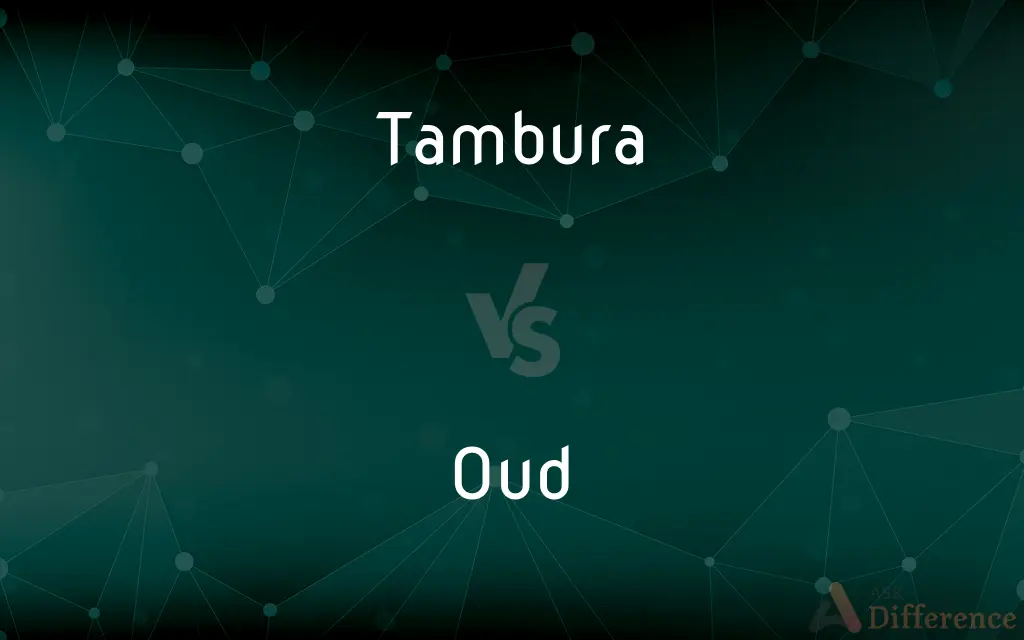Tambura vs. Oud — What's the Difference?
By Tayyaba Rehman & Maham Liaqat — Updated on May 2, 2024
The tambura is a long-necked, plucked string instrument from South Asia, known for its drone sounds; the oud is a pear-shaped, fretless lute from the Middle East, valued for its deep, rich sound.

Difference Between Tambura and Oud
Table of Contents
ADVERTISEMENT
Key Differences
The tambura, also known as tanpura, is a traditional South Asian string instrument primarily used in Indian classical music to provide a continuous harmonic drone. It has a long neck and typically four to six strings that are plucked repetitively. Whereas, the oud is a short-necked, pear-shaped stringed instrument prevalent in Middle Eastern and Mediterranean music, characterized by its fretless neck which allows for a wide range of microtonal sounds.
In terms of construction, the tambura has a relatively flat body with a round, resonating chamber made of wood or gourd, and its strings are made of metal. It is played by plucking the strings with the fingers, which creates a resonant, sustained sound that supports the melody. On the other hand, the oud has a more complex body shape with a curved back, made up of ribbed strips of wood, and it uses gut or nylon strings, which contribute to its distinctive, deep, and resonant tone.
Musically, the tambura does not change its pitch and is used to maintain a static harmonic background, helping musicians stay in tune and providing a meditative quality to the music. Conversely, the oud is used for melodic expressions; it is played with a plectrum and involves complex finger techniques, offering a wide range of dynamics and expressive capabilities in performances.
The tambura is integral to the spiritual and contemplative aspects of Indian music, emphasizing stability and continuity. It is often associated with vocal music but also accompanies instrumental pieces. The oud, however, plays a central role in Middle Eastern music ensembles, comparable to the role of a guitar in Western music, and is used both as a solo and accompanying instrument.
The tambura holds a sacred place in Indian music, symbolizing the unchanging eternal essence in philosophical terms. The oud's influence spans across various cultures from the Middle East to North Africa, playing a pivotal role in musical traditions and often featuring in contemporary fusion genres.
ADVERTISEMENT
Comparison Chart
Shape
Long-necked, flat body
Pear-shaped, fretless with a curved back
Origin
South Asia
Middle East
Strings
4 to 6 metal strings
Usually 11 strings in 5 or 6 courses
Use
Provides a drone for classical music
Plays melody and accompaniment
Sound
Harmonic, drone sound
Deep, rich, and microtonal
Playing Technique
Plucked repetitively
Played with a plectrum, finger techniques
Compare with Definitions
Tambura
A drone instrument used in Indian classical music.
The tambura's constant hum sets the tone for the raga performance.
Oud
A pear-shaped, fretless stringed instrument from the Middle East.
The oud player captivated the audience with intricate melodies.
Tambura
Plucked string instrument, typically with four strings.
She practiced the tambura daily to perfect her timing.
Oud
Known for its deep, resonant sound.
The oud's rich tones filled the concert hall, evoking emotions.
Tambura
Features a long neck and a flat soundboard.
The musician tuned the tambura carefully before the concert.
Oud
Played using a plectrum or with the fingers.
Her fingers danced across the oud's strings, creating a mesmerizing sound.
Tambura
Used in both vocal and instrumental compositions.
The tambura accompanied the sitar in the classical ensemble.
Oud
Often features in solo and ensemble settings.
The oud solo highlighted his technical prowess and musicality.
Tambura
Essential for creating the tonal foundation in performances.
His tambura playing added a meditative quality to the music.
Oud
Integral to traditional and modern Middle Eastern music.
He incorporated the oud into his jazz compositions for a unique sound.
Tambura
Variant of tamboura.
Oud
The oud (Arabic: عود, romanized: ʿūd, pronounced [ʕuːd]; Somali: kaban or cuud) is a short-neck lute-type, pear-shaped, fretless stringed instrument (a chordophone in the Hornbostel–Sachs classification of instruments), usually with 11 strings grouped in six courses, but some models have five or seven courses, with 10 or 13 strings respectively. The oud is very similar to other types of lutes, and also to Western lutes.
Tambura
(musical instrument) A type of long-necked lute-like stringed instrument found throughout the world.
Oud
A stringed musical instrument of northern Africa and southwest Asia resembling a lute.
Oud
(musical instrument) A short-necked and fretless plucked stringed instrument of the lute family, of Arab and Turkish origin.
Oud
(perfume) Agarwood.
Common Curiosities
What is the primary function of the tambura in music?
The tambura provides a continuous drone in Indian classical music, helping maintain the tonal base for other instruments and vocals.
How are the strings tuned on a tambura compared to an oud?
Tambura strings are tuned to a specific pitch to create a drone, whereas oud strings can be tuned variably for different maqams or musical scales.
What types of music is the oud used in?
The oud is used in a variety of musical styles, from traditional Middle Eastern music to contemporary fusion and world music.
Is it difficult to learn to play the oud?
Learning the oud can be challenging due to its fretless neck and the need for precise finger placement for intonation.
How does the oud differ from the tambura in sound production?
The oud produces a rich, deep sound suitable for melodic play, while the tambura produces a sustained drone for harmonic support.
Can the tambura be used as a solo instrument?
Typically, the tambura is not used solo but as a background drone instrument in Indian music.
What role does the oud play in a music ensemble?
In ensembles, the oud often takes a leading or solo role, providing both melody and rhythm.
Why is the tambura important in Indian classical music?
It sets the harmonic framework and supports the spiritual and meditative aspects of the music.
Can the oud be used in Western music?
Yes, the oud is increasingly incorporated into Western music genres like jazz and classical music for its unique sound and versatility.
How does the sound of the tambura enhance Indian music performances?
It provides a sonorous backdrop that enriches the music's emotional and tonal depth.
How does one maintain a tambura?
Maintenance involves regular tuning, cleaning, and occasionally replacing the strings to ensure quality sound.
What materials are used to make an oud?
Ouds are typically made from various woods like walnut, rosewood, and ebony, with gut or nylon strings.
How is the playing technique different between the tambura and the oud?
The tambura involves repetitive plucking of strings for a drone, while the oud requires diverse plucking and strumming techniques for melodies and rhythms.
What are the challenges faced by new learners of the tambura?
New learners must develop a sense of timing and consistency in plucking to maintain the steady drone essential for classical performances.
What is the historical origin of the oud?
The oud has ancient roots, possibly dating back to the Assyrians and certainly prominent in medieval Islamic cultures.
Share Your Discovery

Previous Comparison
Disproportional vs. Disproportionately
Next Comparison
Quietened vs. QuietedAuthor Spotlight
Written by
Tayyaba RehmanTayyaba Rehman is a distinguished writer, currently serving as a primary contributor to askdifference.com. As a researcher in semantics and etymology, Tayyaba's passion for the complexity of languages and their distinctions has found a perfect home on the platform. Tayyaba delves into the intricacies of language, distinguishing between commonly confused words and phrases, thereby providing clarity for readers worldwide.
Co-written by
Maham Liaqat















































